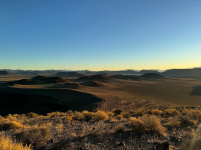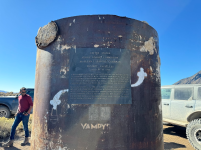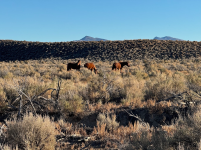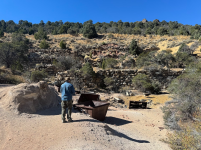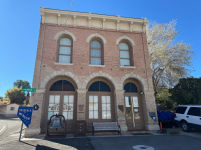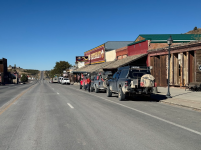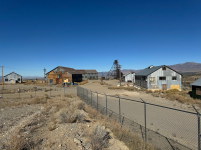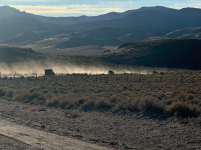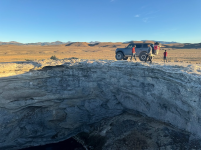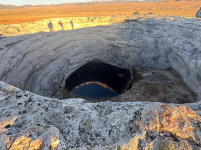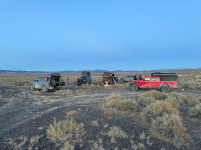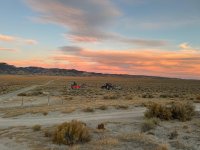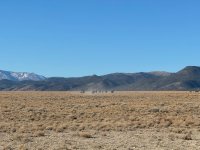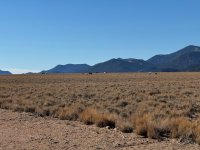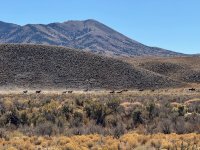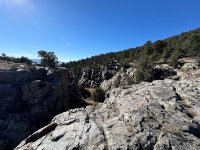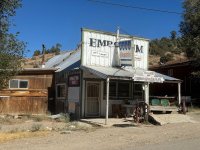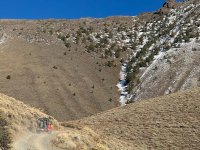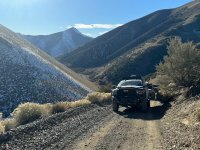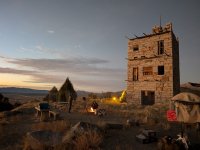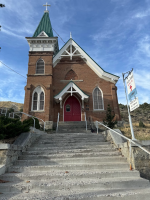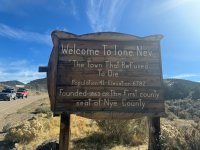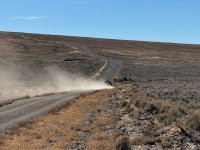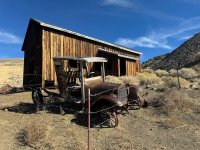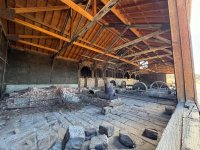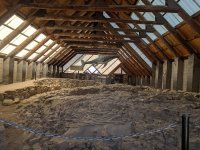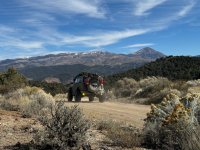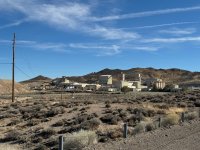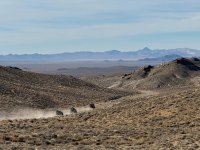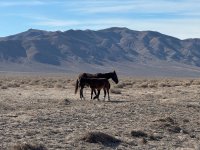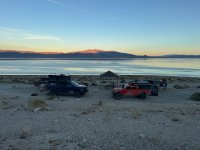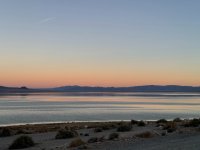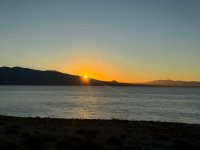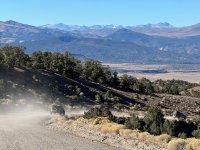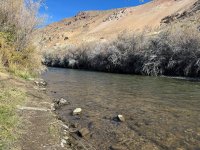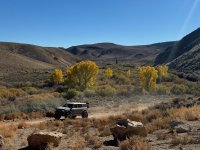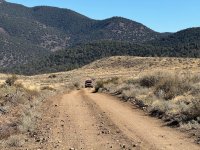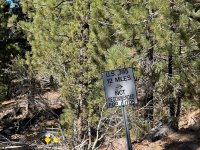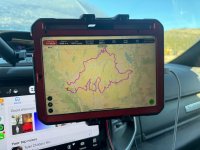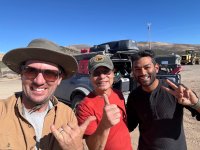OTG_1
Well-known member
Day 9: Ward Mining District to Lunar Crater
With the wind howling the night before, and Ely's reputation for having one of the coldest climates in the lower 48, we were prepared for subfreezing temps into the low 20s. But the bitter cold temperatures we were expecting, never came to fruition. It wasn't warm per se, but if it did dip down to freezing, it was only for an hour or two. By the time the sun began rising over the Basin Ranges, temps ascended into the 40s and then 50s pretty rapidly.
Our first order of business was to check out the remaining buildings at the old Ward Mine. An old warehouse had seen better days as it's aluminum corregated roof was beginning to cave in. The old warehouse stored thousands of core samples, many of which are still neatly organized and labeled in hundreds of cardboard boxes within the warehouse. It's pretty cool to pick up one of these core samples samples, and then to imagine that it was extraced out of the earth several thousand feet below us-- who knows if this is true, but it makes a great story! The one thing that is certainly a bit concerning, and this seems to be a constant within the extraction of minerals, metals, and other resources, is that these mining companies can simply just leave all this crap here! While some of the old mining relics give a sense of novelty, it's not difficult to see why so many mining companies have such bad environmental track records. We always harp on folks who don't clean up their camp, well it seems the mining industry at large never got the message :/
After our quick tour of the remnants of the old Ward Mine, we headed back down the mountain to the massive stone charcoal kilns that were used to separate silver from the mined ore. The impressive kilns stood about 30 feet tall. It was said that it took 6 acres of juniper and bristlecone to fill one of the kilns with charcoal. Local tribes like the Shoshone and Paiute relied on the harvesting of Pinyon pine seeds as one of their major food sources, and as miners and settlers cut down the juniper and pinyon woodlands, unsurprisingly, it became a major source of contention between native groups and the settlers who were encroaching on their ancestral lands.
But we had a lot of mileage to make, so soon enough we were back in our rigs and kicking up a smokescreen of desert dust. We wrapped through a series of canyons near Red Mountain. For a few miles, it felt as if we were in southern Nevada or southern Utah. The rocks looked like weathered greenish and red sandstone, but after some quick research, the surrounding mountains are a limestone escarpment, while Red Mountain is actually of volcanic origain. Either way, Red Mountain and the surrounding landscape was pretty cool!
Eventaully we made our way to the Lunar Crater backcountry byway. I'm not sure what it is, but I absolutely love driving though and camping next to cinder cone fields. And this valley was filled with cinder cones-- take away the sagebrush cloak and throw in some creosote bush for good measure, and you'd think you were in the Mojave National Preserve, which has an amazing cinder cone field (and fantastic places to camp as well!). We made a beeline to the lunar playa. This was a pretty substantial playa, probably a couple of miles in length and perhaps a half mile wide, and the dried lakebad was super tightly packed. So we did what boys do. We ripped around the playa kicking up more dust, raced each other, and managed to capture some pretty crazy video footage as well.
While our original plans had been to push on north of the lunar crater, upon arriving at the crater, I just couldn't resist proposing this as our camp for the night. The crater sits high above the surrounding cinder cone basin, making its home on the backside of a volcanic hill. We took a side spur which led to an impressive camp at the lip of the crater that also had an amazing view of the cinder cone fields and the lunar playa several miles off in the distance. A warm breeze pushed up an over the crater-- I knew we had to camp here for the night!
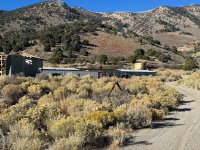
The core sample warehouse at the old Ward mine.
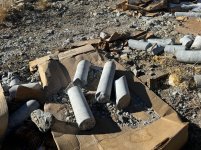
The massive charcoal kilns used to heat up the ore and extract silver from the Ward Mining district.
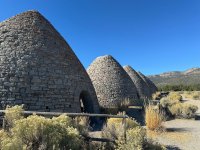
The massive charcoal kilns used to heat up the ore and extract silver from the Ward Mining district.
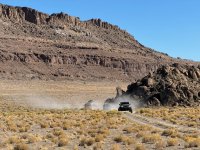
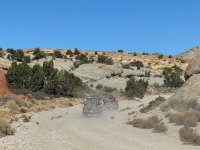
This section of wavy green and red rocks near Red Mountain had us feeling like we were in Gold Butte National Monument in southern Nevada.
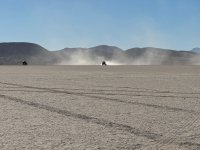
Racing across the Lunar Playa
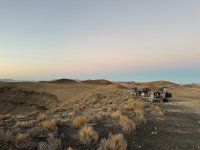
The Lunar Crater was definitely in my top 3 campsites for the trip!
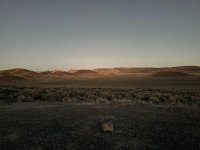
Looking over the cinder cone fields.
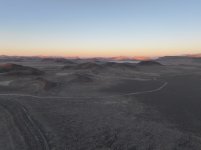
Can you spot the Lunar playa in the distance?
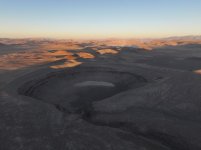
If you blow this image up, you might be able to see our group. Imagine this is a baseball diamond, our camp sits at around where the first basemen would position himself-- lightly left of first base.
With the wind howling the night before, and Ely's reputation for having one of the coldest climates in the lower 48, we were prepared for subfreezing temps into the low 20s. But the bitter cold temperatures we were expecting, never came to fruition. It wasn't warm per se, but if it did dip down to freezing, it was only for an hour or two. By the time the sun began rising over the Basin Ranges, temps ascended into the 40s and then 50s pretty rapidly.
Our first order of business was to check out the remaining buildings at the old Ward Mine. An old warehouse had seen better days as it's aluminum corregated roof was beginning to cave in. The old warehouse stored thousands of core samples, many of which are still neatly organized and labeled in hundreds of cardboard boxes within the warehouse. It's pretty cool to pick up one of these core samples samples, and then to imagine that it was extraced out of the earth several thousand feet below us-- who knows if this is true, but it makes a great story! The one thing that is certainly a bit concerning, and this seems to be a constant within the extraction of minerals, metals, and other resources, is that these mining companies can simply just leave all this crap here! While some of the old mining relics give a sense of novelty, it's not difficult to see why so many mining companies have such bad environmental track records. We always harp on folks who don't clean up their camp, well it seems the mining industry at large never got the message :/
After our quick tour of the remnants of the old Ward Mine, we headed back down the mountain to the massive stone charcoal kilns that were used to separate silver from the mined ore. The impressive kilns stood about 30 feet tall. It was said that it took 6 acres of juniper and bristlecone to fill one of the kilns with charcoal. Local tribes like the Shoshone and Paiute relied on the harvesting of Pinyon pine seeds as one of their major food sources, and as miners and settlers cut down the juniper and pinyon woodlands, unsurprisingly, it became a major source of contention between native groups and the settlers who were encroaching on their ancestral lands.
But we had a lot of mileage to make, so soon enough we were back in our rigs and kicking up a smokescreen of desert dust. We wrapped through a series of canyons near Red Mountain. For a few miles, it felt as if we were in southern Nevada or southern Utah. The rocks looked like weathered greenish and red sandstone, but after some quick research, the surrounding mountains are a limestone escarpment, while Red Mountain is actually of volcanic origain. Either way, Red Mountain and the surrounding landscape was pretty cool!
Eventaully we made our way to the Lunar Crater backcountry byway. I'm not sure what it is, but I absolutely love driving though and camping next to cinder cone fields. And this valley was filled with cinder cones-- take away the sagebrush cloak and throw in some creosote bush for good measure, and you'd think you were in the Mojave National Preserve, which has an amazing cinder cone field (and fantastic places to camp as well!). We made a beeline to the lunar playa. This was a pretty substantial playa, probably a couple of miles in length and perhaps a half mile wide, and the dried lakebad was super tightly packed. So we did what boys do. We ripped around the playa kicking up more dust, raced each other, and managed to capture some pretty crazy video footage as well.
While our original plans had been to push on north of the lunar crater, upon arriving at the crater, I just couldn't resist proposing this as our camp for the night. The crater sits high above the surrounding cinder cone basin, making its home on the backside of a volcanic hill. We took a side spur which led to an impressive camp at the lip of the crater that also had an amazing view of the cinder cone fields and the lunar playa several miles off in the distance. A warm breeze pushed up an over the crater-- I knew we had to camp here for the night!

The core sample warehouse at the old Ward mine.

The massive charcoal kilns used to heat up the ore and extract silver from the Ward Mining district.

The massive charcoal kilns used to heat up the ore and extract silver from the Ward Mining district.


This section of wavy green and red rocks near Red Mountain had us feeling like we were in Gold Butte National Monument in southern Nevada.

Racing across the Lunar Playa

The Lunar Crater was definitely in my top 3 campsites for the trip!

Looking over the cinder cone fields.

Can you spot the Lunar playa in the distance?

If you blow this image up, you might be able to see our group. Imagine this is a baseball diamond, our camp sits at around where the first basemen would position himself-- lightly left of first base.

